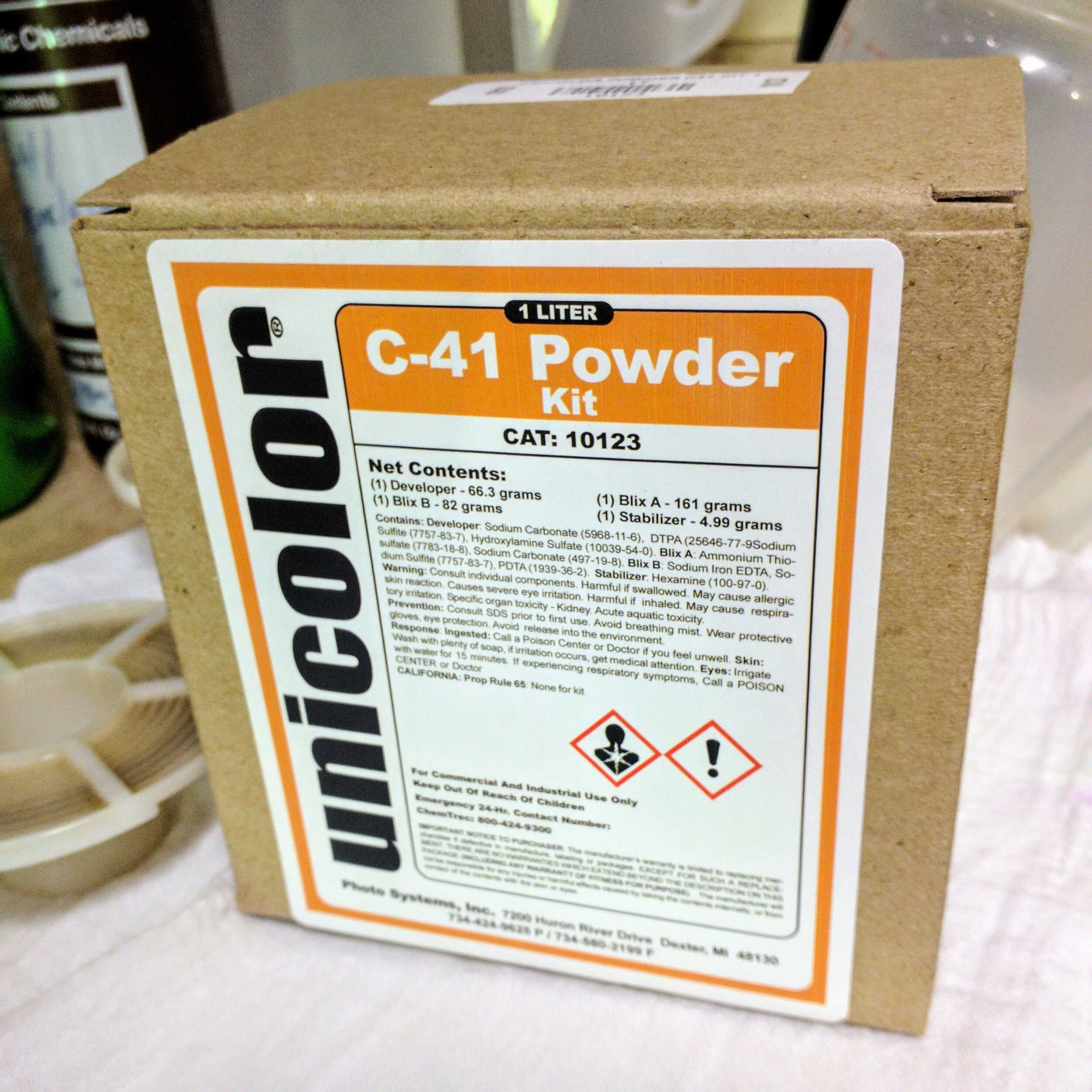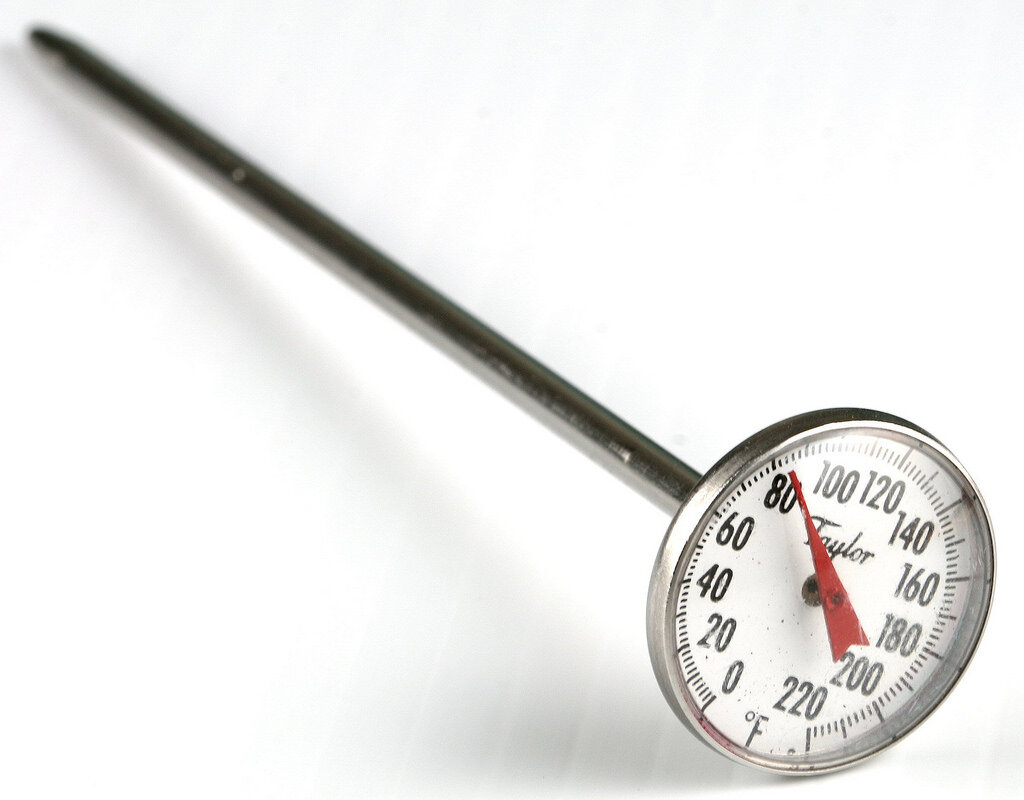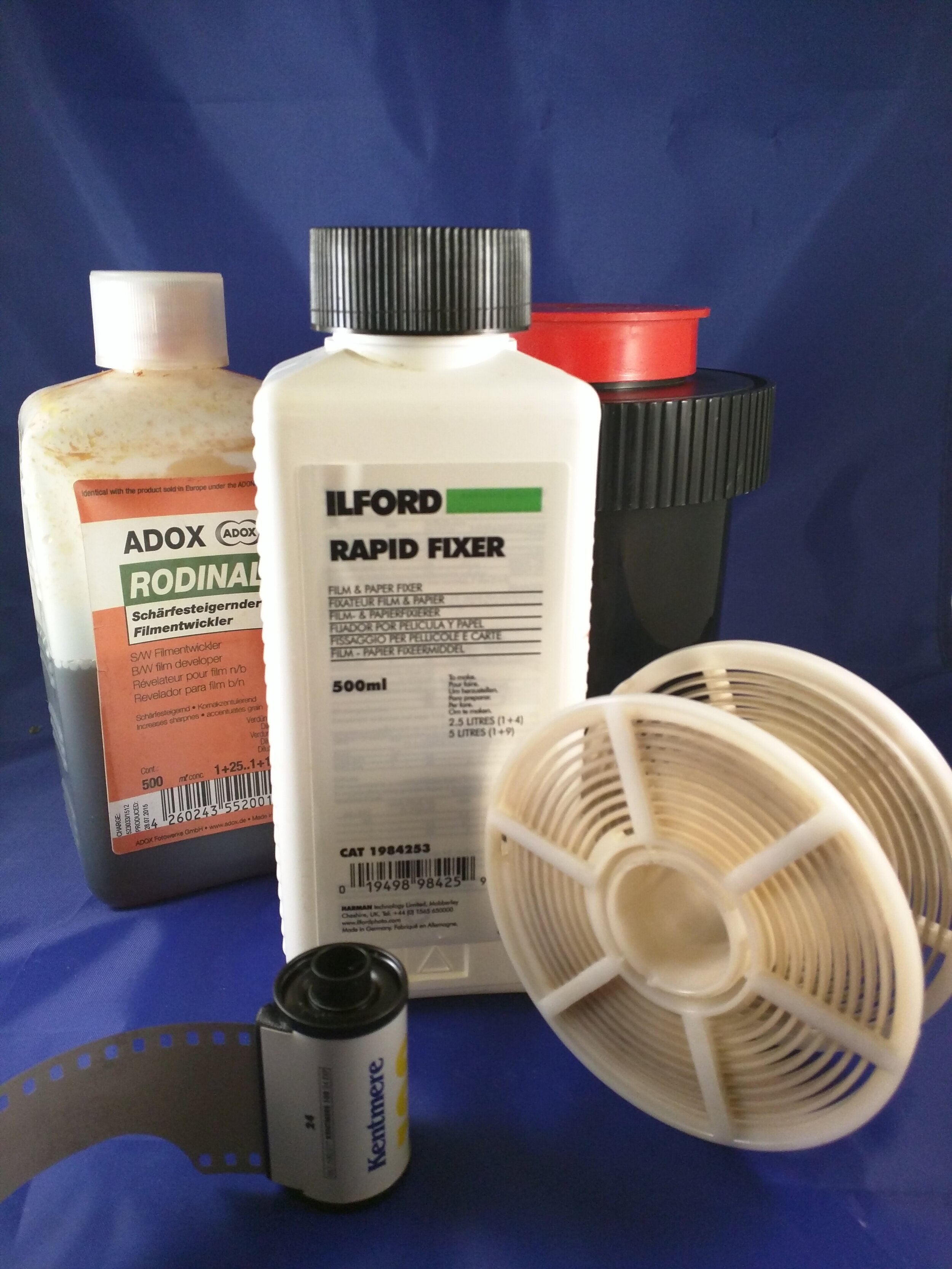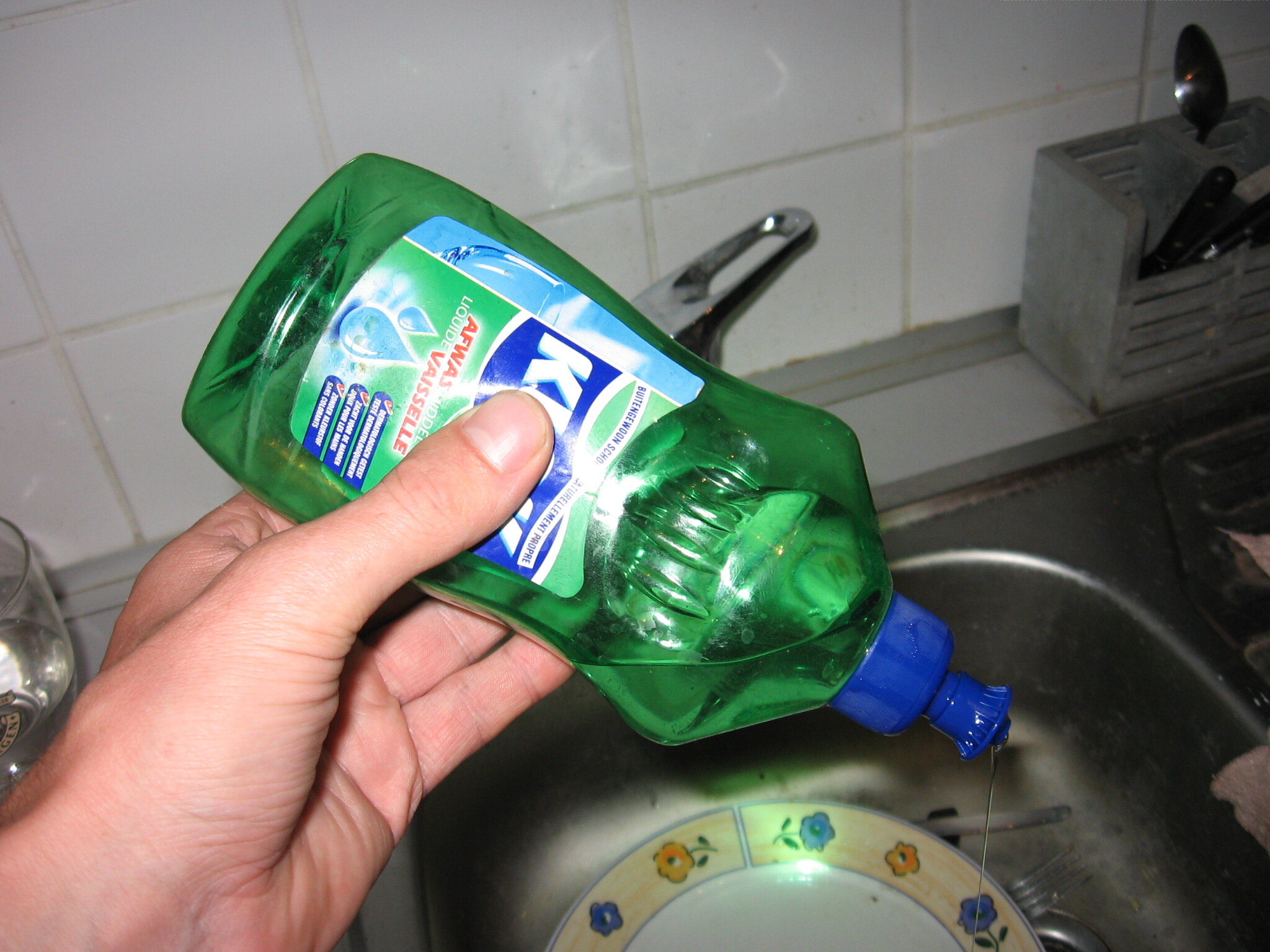Color film (C41) has a reputation for being needy when developed, due to its precise time and temperature requirements. One pass over the instructions and you’ll see that it’s 102.5F exactly, for 3:30s exactly, and Bleach/Fix for 6:30 exactly, and rinse for 3:00 at 100F exactly. After a couple years experience developing in my kitchen, I’d like to correct a few misconceptions about this, and hopefully encourage you not to simply shoot black and white film because it’s somehow easier to develop. If you’re sitting at home with a color-print lab, or are really anal about chemistry, this article isn’t directed at you. Still, you might find it an interesting read.
The Press Kit – Your Entry to Color Developing
 Let’s light this Popsicle stand! You’re likely going to want some chemicals if you’re going to develop color film. Unlike black and white, C41 film doesn’t have a home-brew coffee solution. I use the Unicolor (also sold as Tetanol) C-41 kit. It’s about $25 for a 1 liter kit. It comes in powder form, so if you’re going to do a lot of color developing or just want to stock up, the stuff is pretty shelf-stable in powder form. It’s also fool-proof to mix it, and the instructions are well-written. Here’s a little secret: word has it this “kit” was designed to be used by photographers in the field with access to nothing more than a bathroom in a hotel. Precision is pretty much tossed out the window.
Let’s light this Popsicle stand! You’re likely going to want some chemicals if you’re going to develop color film. Unlike black and white, C41 film doesn’t have a home-brew coffee solution. I use the Unicolor (also sold as Tetanol) C-41 kit. It’s about $25 for a 1 liter kit. It comes in powder form, so if you’re going to do a lot of color developing or just want to stock up, the stuff is pretty shelf-stable in powder form. It’s also fool-proof to mix it, and the instructions are well-written. Here’s a little secret: word has it this “kit” was designed to be used by photographers in the field with access to nothing more than a bathroom in a hotel. Precision is pretty much tossed out the window.
Thermometers are for Wimps
 I kid, really. Thermometers are important, but accurate to the tenths is not. The kit suggests warming the chemicals in a waterbath to 102.5F, and then maintaining that temperature for the 3:30s needed to develop the film. Here’s the problem with that nonsense: there isn’t an easy way, outside of sticking the thermometer down into the old Paterson tank, of monitoring the temperature of the developer once you start processing your film. That’s a hassle. The actual process is a little more carefree. First, get the hottest water you can into a big pot. Put your developer and blix bottles into the pot, and cover them with the hot water. Drop a clean meat thermometer into the top of the developer bottle and walk away. Go grab a darkbag or a dark closet, load your film onto the spool, and load the spool into your Paterson tank. When you come back, your developer temperature should be hovering between 100 and 104. You’re set. Fill your Paterson with warm water to soak for a minute, then dump that and begin the real process of developing. Don’t worry about keeping it exactly at temp anymore, you’re only going to steep the film for three and a half minutes anyway.
I kid, really. Thermometers are important, but accurate to the tenths is not. The kit suggests warming the chemicals in a waterbath to 102.5F, and then maintaining that temperature for the 3:30s needed to develop the film. Here’s the problem with that nonsense: there isn’t an easy way, outside of sticking the thermometer down into the old Paterson tank, of monitoring the temperature of the developer once you start processing your film. That’s a hassle. The actual process is a little more carefree. First, get the hottest water you can into a big pot. Put your developer and blix bottles into the pot, and cover them with the hot water. Drop a clean meat thermometer into the top of the developer bottle and walk away. Go grab a darkbag or a dark closet, load your film onto the spool, and load the spool into your Paterson tank. When you come back, your developer temperature should be hovering between 100 and 104. You’re set. Fill your Paterson with warm water to soak for a minute, then dump that and begin the real process of developing. Don’t worry about keeping it exactly at temp anymore, you’re only going to steep the film for three and a half minutes anyway.
Agitation is agitating
 Agitation is the process of inverting the Paterson tank at set intervals. As the developer sits motionless against the film, its chemical properties become depleted. Since the chemicals are not moving, they need to be replenished to boost the properties. This is agitation. The instructions will have you invert the tank, but the purpose of inversion is to pass fresh chemicals over the film. It’s not how you agitate, it’s that you agitate. Sometimes I invert, sometimes I swirl around the container like an upside-down martini. It’s really not rocket science. The half-minute marks are more of a guideline, kinda like Pirate Code. If you skip an inversion at 30 seconds or wait until 40 seconds, it doesn’t matter much. Again, that you’re periodically agitating is what’s important.
Agitation is the process of inverting the Paterson tank at set intervals. As the developer sits motionless against the film, its chemical properties become depleted. Since the chemicals are not moving, they need to be replenished to boost the properties. This is agitation. The instructions will have you invert the tank, but the purpose of inversion is to pass fresh chemicals over the film. It’s not how you agitate, it’s that you agitate. Sometimes I invert, sometimes I swirl around the container like an upside-down martini. It’s really not rocket science. The half-minute marks are more of a guideline, kinda like Pirate Code. If you skip an inversion at 30 seconds or wait until 40 seconds, it doesn’t matter much. Again, that you’re periodically agitating is what’s important.
Why the blix are my photos pink ?
 The follow-up to developing is Bleaching and Fixing. Conveniently, the press kit comes with a nasty caustic mix of the two called Blix. It’s the color of coffee, but has the smell of death, so don’t set your coffee mugs anywhere near it. Trust me. So Blix has some temperature settings, also. It’s roughly the same as the developer, but here’s where it gets weird. If your blix is too cool, you’ll get a magenta cast to your negatives. This is a royal pain in the ass…… if you’re one of those people that’s printing direct from the negatives. In this case, you’re probably not going to take anything I say seriously anyway.The reality is, most of us are going to scan our negatives and then put the negatives away. Most of us also have flatbed scanners that do a damn good job at color correction, or we have a basic understanding of temperature and tone and can ditch the pink hue in a photo editor.Here’s the trick, though. You can take your Blix out of the bath and it will still be at a good temp to avoid the magenta hue as long as you aren’t developing in the arctic circle where the chems would super-cool quickly.
The follow-up to developing is Bleaching and Fixing. Conveniently, the press kit comes with a nasty caustic mix of the two called Blix. It’s the color of coffee, but has the smell of death, so don’t set your coffee mugs anywhere near it. Trust me. So Blix has some temperature settings, also. It’s roughly the same as the developer, but here’s where it gets weird. If your blix is too cool, you’ll get a magenta cast to your negatives. This is a royal pain in the ass…… if you’re one of those people that’s printing direct from the negatives. In this case, you’re probably not going to take anything I say seriously anyway.The reality is, most of us are going to scan our negatives and then put the negatives away. Most of us also have flatbed scanners that do a damn good job at color correction, or we have a basic understanding of temperature and tone and can ditch the pink hue in a photo editor.Here’s the trick, though. You can take your Blix out of the bath and it will still be at a good temp to avoid the magenta hue as long as you aren’t developing in the arctic circle where the chems would super-cool quickly.
Stabilizer is code for Dish Soap
 Here’s where I veer entirely off the reservation and tell you that I never use the stabilizer that comes with the kit. It’s basically supposed to reduce spotting and add a bit of longevity to the film, but honestly every howto I’ve ever read or watched says to ditch it in favor of dish soap. The point of the dish soap is to reduce spotting as the film dries. One tiny drop in the water after you’d done rinsing the film, thirty seconds of agitation, and you’ve ‘stabilized’ your negatives. Squeegee it with your fingers and hang it up to dry.
Here’s where I veer entirely off the reservation and tell you that I never use the stabilizer that comes with the kit. It’s basically supposed to reduce spotting and add a bit of longevity to the film, but honestly every howto I’ve ever read or watched says to ditch it in favor of dish soap. The point of the dish soap is to reduce spotting as the film dries. One tiny drop in the water after you’d done rinsing the film, thirty seconds of agitation, and you’ve ‘stabilized’ your negatives. Squeegee it with your fingers and hang it up to dry.
How reckelss of you!
I know, it sounds very careless. I’ve thrown caution to the wind and I’ll get nothing but wasted negatives and inconsistent results. The truth, however, is that my results are pretty consistent. In fact, I’ve developed probably a hundred color rolls and had one that came out pink. Don’t take my word for it, read the back page of the instructions for the kit. “You can…extend the life…if you take risks…” basically telling you that even though your chemicals are designed for 8 rolls, they’ll successfully develop many more rolls. I’ve done 30 from one kit. Let’s be real, we’re experimenting with film, anyway. It’s a niche medium and it’s extremely fun to tinker with. The alternative is plugging an SD card into your computer.The takeaway is this: don’t let all these precise times and measurements, or the scary stories on the Web deter you from trying your hand at color film development. With color film you get to try things like “Cross Processing” where you shoot an entire roll of Slide Reversal Film (E-6) and develop it in C-41. You also get to shoot through rolls of expired color film to see what effect aging has on color films, and you can develop it in your kitchen!


phil
I shoot probably a roll of B/W film every 4-7 days, but maybe a half-dozen rolls of color film each year. I tend to bunch those up to take advantage of the fresh color chemicals (also using the Unicolor kit). But what do you suppose the shelf life is of the mixed chemicals? 10 rolls over the course of one year — one kit?Just curious about your thoughts.
Chipboard Floozy
I’ve done about 20 rolls or so over 6 months. I keep my chemicals in dark brown plastic datatainer bottles. I’m sitting on about 35 rolls of color film and some relatively fresh chemicals so it’ll be interesting to see how far I can stretch it. 😁